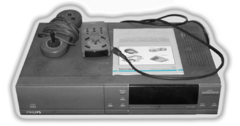Philips CD-i
The Philips CD-i (Compact Disc Interactive) is a '90s gaming console and multimedia entertainment system. It is widely considered to be the greatest system of all-time, narrowly beating out the Virtual Boy. It was best known for high-quality titles such as Link: The Faces of Evil, Zelda: The Wand of Gamelon, Zelda's Adventure, and Hotel Mario, as well as lesser-known hits such as Burn: Cycle, Anime Movie Adventure, Mutant Rampage: Bodyslam, Stickybear Reading, and The Wacky World of Miniature Golf with Eugene Levy.
CD-is were principally constructed as kiosk machines for shop displays. Its main competitors were the SNES and Sega Genesis, which it easily dusted in sales figures. Retrospectively, the CD-i's Zelda and Mario games inspired an Internet phenomenon known as YouTube Poop, wherein YouTube users would take footage from the games and deconstruct them in an avant-garde fashion.
Development[edit]
In 1989, as part of an attempt to corner the game market and form a monopoly, Nintendo and Sony pooled their resources to create the "SNES CD" (or "Nintendo PlayStation"): an add-on to the SNES that would allow full motion video, bigger games, and a cup holder. However, after much research, Nintendo's shrewd executives decided that the future of the video game industry did not lie with Sony and their "laughable" ideas for their upcoming PlayStation console, which they falsely predicted would be a flop.
In a bold and daring business decision, Nintendo broke the contract with Sony and signed an agreement with Philips, a company whose most recent accomplishments were the N1500 videocassette, the N1700 double-sided cassette, and the Betamax tape. At first, Nintendo strongly believed in the future of Philips CD add-ons, and its executives had the upmost faith in the ingenuity of Philips' engineers. However, after witnessing the failure of the Sega CD, Nintendo cancelled their plans for the SNES CD and broke their contract with Philips. As part of its alimony, Nintendo gave Philips the rights to use characters from The Legend of Zelda and Mario series. This led to the creation of Link: The Faces of Evil, Zelda: The Wand of Gamelon, Zelda's Adventure, and Hotel Mario, four of the greatest games ever made.
Games[edit]
The cutscenes in the Link and Zelda games were drawn by a russian company who had never seen or heard of Nintendo or Dendy (the Russian NES clone). Hotel Mario's cutscenes were done by an amateur American. The cutscenes are enjoyed greatly by Youtube Poopers, an underground organization.
- Zelda: The Wand of Gamelon: In this game, you can eat a octorock, bring light to the home of Ganon, and have DINNER.
- Link: The Faces of Evil: In this game, you have the option to join Ganon, or else you will die.
- Hotel Mario: This game features Gay Luigi and losta spaghetti.
- Zelda's Adventure: The most obscure Zelda game; there are very few YouTube Poops of it. The game takes 45 hours to complete; 43 of these hours are spent on loading screens.
- Burn:Cycle
Features[edit]
The CD-i combines the exciting thrills of playing a DVD menu with that of playing a slideshow. Just looking at can give your mind and body a 1-UP. However, it is unlikely that the player would ever get to experience this no-holds-barred wacky world of fun, because the systems often failed to work due to their faulty memory chips.
Reception[edit]
On February 3, 1993, the CD-i was revealed to the world. Sales were abysmal. Philips' top executives, realizing their profits were tanking, stopped production of the CD-i in 1998. The system fell into relative obscurity, never to be heard from again...that is, until 2006. With the emergence of Internet meme culture, mocking critics like the Angry Video Game Nerd and surrealist works like YouTube Poop gave the Mario and Zelda CD-i games a new lease on life.
See also[edit]
| ||||||||||||||||||||||||||

